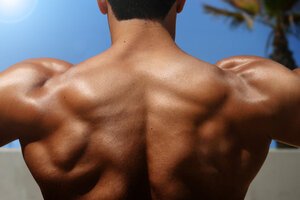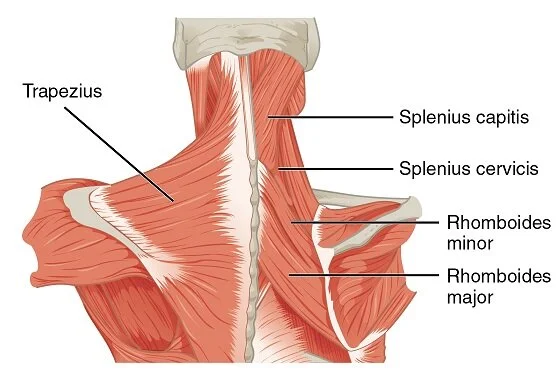The 7 Best Trapezius Exercises to Grow your Traps
7 of the best exercises for your trapezius including Upper, Middle, Lower and BodyWeight exercises
When people look at bodybuilders, they often notice how sculpted and long their necks are. It's because their trapezius, a big stingray-shaped muscle, has been overworked.
Starting behind the head, the trapezius travels down the neck and over the shoulders before curving downward in a "V" form to finish at the base of the spine.
Yes, big-armed men catch your eye, but it’s the huge men who hold your attention. You can be confident they put in the effort and didn't skip exercises due to being "tired." You admire their strength and inwardly want their arms.
There are no shortcuts when it comes to trapezius training. It requires significant time, energy, and guts.
There is disagreement about the optimum day to exercise the trapezius muscles. Some people believe it's a day for their shoulders, while others claim it's a day for their back. Honestly, you'll hit your traps hard on both days, but in my experience, I find it easier to concentrate on my traps while I'm working on my shoulders.
On back days, I tend to concentrate on the mid and lower back. In contrast, on a shoulder day, I get to compress my traps even more.
Don’t neglect the traps!
The Trapezius Muscle: What Is It?
One of the most prominent muscles of the upper and mid-back is the trapezius, and it can be found from the base of your head down to your lower thoracic vertebrae, as well as extending laterally to the scapular spine.
Trapezius Anatomy & Function
The spinal column has two symmetrical trapezius muscles: one on the left and one on the right. The upper, middle and lower traps of the trapezius muscle are collectively referred to as the traps.
The 7 Best Trapezius Exercises
1. Dumbbell shrugs
Upper Traps muscle fibres respond well to training with a bit of hip hinge and slight neck flexion. Pull the dumbbells up and back in a diagonal motion with your arms. When the exercise is done in this manner, force is transferred from the upper traps' muscle fibres to the body's mid-line, following the muscle fibres' direction.
If you bend your neck just a little bit, the muscles in your shoulder joint will be fully contracted instead of those in your neck. With dumbbells, maintain your shoulders externally rotated and your arms at your sides with a grasp slightly more comprehensive than shoulder-width when completing this exercise. Because the muscle fibres are oriented differently in this exercise, it is significantly better to a standard barbell or dumbbell shrug.
2. Bent-over Dumbbell Rows
Even though this exercise targets the Lats as well, it's excellent for improving Scapula retraction. For this exercise, I like to use dumbbells instead of a barbell as they allow the shoulders to be rotated outside of the chest and provide a broader range of motion.
How to perform a bent over Dumbell row
Using a 45-degree angle, bring the dumbbells to your upper abdomen/lower chest area.
Flexing the abdominals, glutes, and erector spinae keep the spine neutral and the core tight (lower back muscles). Keep your feet parallel to the ground at all times so that the resistance will be focused on the Traps instead of your body.
3. Shoulder blade squeeze
It is best to have workouts that assist the trapezius in performing its job, supporting the shoulder and upper back-unless you're a bodybuilder attempting to develop a big trapezius.
Squeezing the shoulder blades together is a simple method of accomplishing this. Maintain a straight back and shoulders. Hold the shoulder blades together for three seconds while slowly squeezing them together. Return the shoulder blades to a relaxed posture by slowly releasing them. Use a resistance band or hold your arms out in front like a goal post to perform this workout.
4. Shrug
Another technique to keep your trapezius muscles strong is to perform simple shrugs. As Kovacs points out, "the shrug" is an essential and simple exercise that works the trapezius muscles. Use weights in your hands if you want an extra challenge.
Maintain a straight posture as you stand up. Try to reach your ears with your shoulders by raising them as high as you can. Hold for a second before releasing your grip. Restore them to a state of calm and relaxation. Repeat 20 times.
5. The High Pull
Add weight to an Olympic bar, roughly 50% more than you'd use in an upright row performed in strict form. Grab the bar with a wider-than-shoulder-width under-hand grip. Let go of the bar and let it dangle in front of you. Then, with your lower back arched and your butt and shoulders pulled back, drop the bar to full extension.
Use your traps, shoulders, hips, and legs together to raise the bar to your chest when it's about two inches over your knee cap. Gravity will bring the bar back down once it reaches its final destination. Be sure to make use of your hips and legs as shock absorbers when moving about.
6. Single-Arm Dumbbell Upright Row
Here, I like to make use of a weight-to-rep ratio strategy. I perform the same number of repetitions with any weight. Then I'll perform 50 repetitions of each arm with a 50-pound dumbbell. If I try to take on too much at once, I'll force myself to take a step back and regroup.
Starting at the elbow is critical for this action. Think of yourself as a puppet with a string around your elbow, that a puppeteer uses to manipulate your arm. Please don't lose sight of this idea: it will serve you well later when you feel fatigued.
7. Low-Cable Face Pull
Use a rope and tie it to the base of a cable rack with an adjustable height. When recruiting those traps, stand approximately two feet away from the attachment to obtain the best viewpoint. Don't halt or rest at the top if you want to utilise this as a fat burner. It's going to be difficult, but keep going until the end.
Choose a weight that's difficult enough to make you want to quit, but not so difficult that you have to cheat your way to the end of the set.
I hope you can put this information to good use in your training, and reach your goal of a thick, full back, and well-developed traps!
Check out our fitness blog for more health, training and fitness content!





